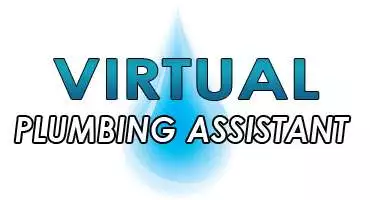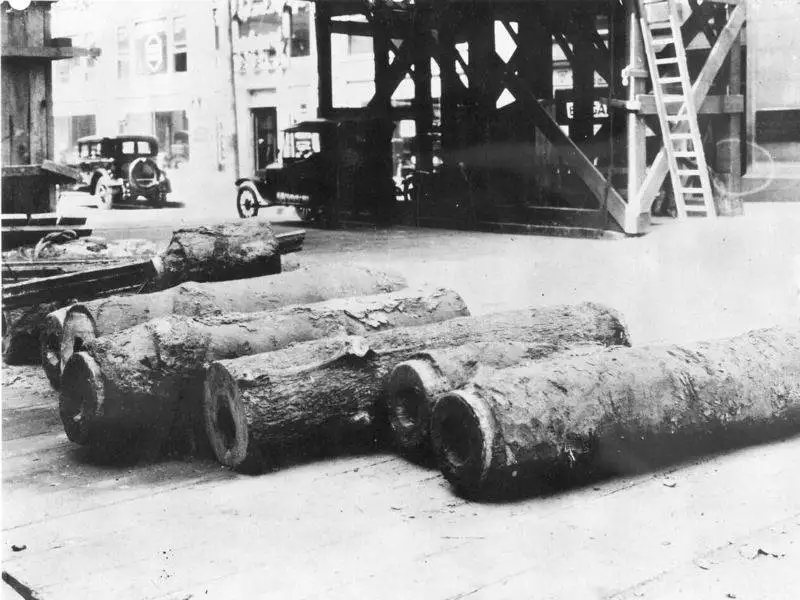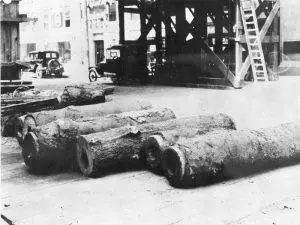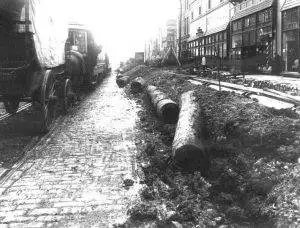Water Service Line History Starts With Wooden Logs
The City of Philadelphia, Pennsylvania was the first city to use lead water lines in 1754. These lines were primarily used as service water lines. Service lines ran from larger main lines on the road to each home or business along the street. Many of the main lines running through the city at that time were made of wood. Primarily Hemlock trees were used to make these “wood log water pipes.” The average length of the water log was 3-4 feet long, however, some were found to be even longer.
The following images are not the property of Virtual Plumbing Assistant. They are displayed here courtesy of and originally posted in this article on the WEF Highlights website.
The logs used for water service lines (water mains) were hollowed out and then a steel strapping was spirally wound around the wood log. This was done to strengthen the piping so it had the ability to withstand higher pressures. Cutting the logs made them easy to be hollowed out and moved around.
One end of the wood log pipe was tapered and the other end was not. This way the tapered end would fit inside the untapered end when the logs were joined together. Once the logs were joined, they were then secured by iron bands.
Cast Iron
In Philadelphia, Pennsylvania wood log water lines were used until about 1832. These logs were prone to leak at cracks and where they were joined together. Cast iron pipes were now replacing wood logs. Cast iron pipes were being used as early as 1820 and then in 1832 wood logs were no longer used. All wooded service lines were removed by 1858 but not all were removed from the ground. Even up to the 1980’s wood log water pipes were still being found. These logs were being unearthed during excavation for the removal of cast iron lines that were being replaced with newer water lines.
Cast iron was now the go-to piping for water mains and service lines. The cast iron lines were larger and stronger which the city needed as it continued to grow. These new cast iron lines not only increased water volumes but were less likely to leak or break. The city used these pipes for both water and sewer lines for many years. Cast iron pipes have been used for water distribution around the world since the mid-1700s.
Cast Iron Problems
Even though cast iron piping was better than wood, it had its problems. Cast piping corrodes from the inside out, so looking at a pipe it may look fine, but the interior of the pipe is slowly eroding. With constant wear from water flow and chemicals, the pipe starts to rust from the inside wearing the pipe down. As the pipe corrodes particles flow through the pipe into your home’s plumbing. This creates scaling and corrosion buildup on plumbing fixtures and many times slows the flow of water.
Eventually, the iron pipe will wear through and leaks occur. In the case of water lines that were buried, foreign material can enter the pipes as holes begin to appear and create possible health issues. Around the 1980s cast iron piping was being replaced with newer style copper piping.
Copper Piping
Copper water piping had been used since the late 1940s. At this time copper was cheaper to manufacture and in many ways easier to use. One restriction of copper piping was the size or diameter that could be made. While it could be made up to 12 inches in diameter the standard was 4 inches and below.
Copper was mainly used as service lines to homes and interior water lines. Water mains were now ductile steel or poly-based lines. These types of mains could be bigger for better volumes and less likely to break or rupture.
Water lines made of copper came in different sizes, thicknesses, and uses. Standard copper piping types are K, L, M, and DWV. K copper is the thickest and most durable. Mainly used in commercial plumbing, HVAC, and underground applications.
L copper piping is a bit thinner than K copper and is used mainly in residential interior piping and some underground applications.
M copper is thinner yet, while it can be used for many applications, being lighter, less rigid, and less expensive this piping is used a lot for hot water heating lines and as replacement water lines where flexibility is needed. Usually seen in coiled rolls for easy use and straight sections twenty feet or less.
DWV copper piping is for drain, waste, and vent. Used in both commercial and residential drains and vents. This drain piping was easier to use than cast iron mainly because of the weight difference. Copper DWV drains were longer lasting in most situations than cast iron. But like any material, constant use does wear copper lines down.
Problems With Copper
Rotting of DWV drains and vents is the most common reason for a replacement! Rotting in drain piping usually occurs on the top of the pipe where condensation sits and slowly erodes the pipe. Also, where joints are made is commonplace for erosion in the pipes. Household and drain cleaning chemicals are why most copper drains fail.
Another reason copper drains and vents fail is from “wet” systems. These are usually systems that are connected to septic tanks. These tanks hold a lot of moisture, condensation then travels up the drain piping clinging to the top of the pipe. Over time this condensation corrodes the top of the pipe causing leaks and worse, sewer gasses.
PEX Piping
Around the time when copper piping was started to be used in the USA, Pex piping was starting to be used in Europe. In the early 1980s Pex piping was starting to be used in the states for radiant floor heating. In the mid to late 1990s Pex piping started to be used widely for plumbing applications. Much of this use came about as the prices for copper and other metals skyrocketed.
Nowadays Pex water lines are used in most residential applications. Pex piping ranges from ½” to 3” pipe size. Residential Pex is normally ½” to 1”, while larger piping can be used in commercial and hydronic heating applications.
CPVC Piping
The other widely used material for water distribution is CPVC. CPVC has been used in the USA since 1959 when it was installed in a home in Michigan. This home was a NAHB (National Association of Home Builders) research program house that became the first home in the world to be built using CPVC as its plumbing system. In certain parts of the country, CPVC is still being used today.
There have been many different materials used for water distribution over the decades. These are just a couple of the more widely used materials that have been used in the USA!
Enjoy the day!!
- How To Make the Call: DIY Plumbing vs. Hiring a Professional - April 9, 2024
- How to Get Online Plumbing Advice: A Step-by-Step Guide - March 14, 2024
- Virtual Plumbing Solutions: Comparing JustAnswer.com - February 19, 2024




0 Comments